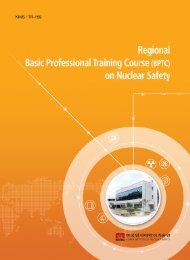PROSPER guidelines - Nuclear Safety and Security - IAEA
PROSPER guidelines - Nuclear Safety and Security - IAEA
PROSPER guidelines - Nuclear Safety and Security - IAEA
Create successful ePaper yourself
Turn your PDF publications into a flip-book with our unique Google optimized e-Paper software.
2.3. STRATEGY<br />
To provide timely identification, analysis <strong>and</strong> correction of adverse deviating conditions<br />
important to NPP safety, it is desirable that utility/NPP operators have in place a systematic<br />
OE process. The deviating conditions addressed by the OE process ranges from significant to<br />
near miss events <strong>and</strong> thus allow for the correction of initiators <strong>and</strong> prevention of their<br />
recurrence, which could lead to significant safety events. The OE process also includes a<br />
feedback mechanism to correct minor OE process deficiencies, which will then contribute to<br />
improved safety performance.<br />
2.3.1. Attributes<br />
The utility/NPP operator takes account of regulatory policy <strong>and</strong> guidance when establishing<br />
<strong>and</strong> implementing an OE process. The regulatory requirements or <strong>guidelines</strong> are regarded as<br />
minimum criteria.<br />
In order that the OE process is effectively managed <strong>and</strong> retains credibility, the utility/NPP<br />
must make a positive commitment to its implementation <strong>and</strong> execution. The overall aim of the<br />
OE process is set out in a clear policy statement which commits the utility/NPP to the<br />
enhancing the prevention of events important to safety, i.e. the required capability of Process<br />
<strong>and</strong> activities to identify, analyse <strong>and</strong> eliminate latent weaknesses <strong>and</strong> hence prevent<br />
recurrence.<br />
Due account is taken of any available national <strong>and</strong> international guidance including the <strong>IAEA</strong><br />
<strong>Safety</strong> St<strong>and</strong>ards <strong>and</strong> good practices in the OE process management.<br />
The scope of the OE process is clearly defined <strong>and</strong> includes the identification of unresolved<br />
safety issues of a generic nature.<br />
2.3.2. Documentation<br />
a) regulatory policy <strong>and</strong> requirements (nuclear, health <strong>and</strong> safety, environmental, etc.)<br />
b) international <strong>guidelines</strong> (<strong>IAEA</strong>, WANO, INPO, NEA, etc.)<br />
c) operational experience review policy of the utility/NPP<br />
d) reporting criteria (regulatory, utility, plant).<br />
2.3.2. Self-assessment review topics<br />
a) Is the policy of the nuclear safety regulatory authority on operational experience review<br />
complied within the written plant guidance documentation?<br />
b) Are any additional regulatory requirements <strong>and</strong> guidance provided by other bodies<br />
(environmental, health <strong>and</strong> safety, etc.) included in the written plant guidance<br />
documentation?<br />
c) Within the operational experience review policy documentation of the NPP, are there clear<br />
policy statements regarding:<br />
• the use of OE results;<br />
• the operator’s commitment to the OE process;<br />
• regular effectiveness reviews (e.g. monthly) <strong>and</strong> self-assessments (e.g. yearly);<br />
• the operator’s intent to continuously improve performance through the use of OE<br />
review.<br />
8
















